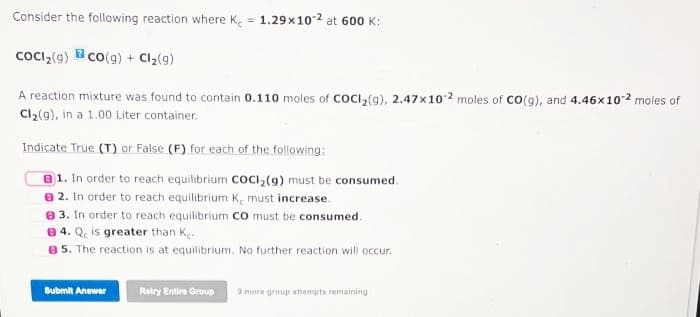Consider the following reaction where Ke 1.29x10-2 at 600 K: = CoCl₂(g) co(g) + Cl₂(g) A reaction mixture was found to contain 0.110 moles of COCI₂(g), 2.47x102 moles of CO(g), and 4.46x102 moles of Cl₂(9), in a 1.00 Liter container. Indicate True (T) or False (F) for each of the following: 1. In order to reach equilibrium COCI₂ (9) must be consumed. @ 2. In order to reach equilibrium K, must increase. 3. In order to reach equilibrium CO must be consumed. 84. Qe is greater than Ke 5. The reaction is at equilibrium. No further reaction will occur.
Consider the following reaction where Ke 1.29x10-2 at 600 K: = CoCl₂(g) co(g) + Cl₂(g) A reaction mixture was found to contain 0.110 moles of COCI₂(g), 2.47x102 moles of CO(g), and 4.46x102 moles of Cl₂(9), in a 1.00 Liter container. Indicate True (T) or False (F) for each of the following: 1. In order to reach equilibrium COCI₂ (9) must be consumed. @ 2. In order to reach equilibrium K, must increase. 3. In order to reach equilibrium CO must be consumed. 84. Qe is greater than Ke 5. The reaction is at equilibrium. No further reaction will occur.
Chemistry
10th Edition
ISBN:9781305957404
Author:Steven S. Zumdahl, Susan A. Zumdahl, Donald J. DeCoste
Publisher:Steven S. Zumdahl, Susan A. Zumdahl, Donald J. DeCoste
Chapter17: Spontaneity, Entropy, And Free Energy
Section: Chapter Questions
Problem 118CP: Consider the reaction H2(g)+Br2(g)2HBr(g) where H = 103.8 kJ/mol. In a particular experiment, equal...
Related questions
Question

Transcribed Image Text:Consider the following reaction where Ke = 1.29x102 at 600 K:
CoCl₂(g) CO(g) + Cl₂(g)
A reaction mixture was found to contain 0.110 moles of COCl₂(g), 2.47x102 moles of CO(g), and 4.46x102 moles of
Cl₂(9), in a 1.00 Liter container.
Indicate True (T) or False (F) for each of the following:
1. In order to reach equilibrium COCI₂(g) must be consumed.
2. In order to reach equilibrium K, must increase.
3. In order to reach equilibrium CO must be consumed.
84. Qe is greater than Ke
5. The reaction is at equilibrium. No further reaction will occur.
Submit Answer
Retry Entire Group 9 more group attempts remaining
Expert Solution
This question has been solved!
Explore an expertly crafted, step-by-step solution for a thorough understanding of key concepts.
Step by step
Solved in 2 steps with 2 images

Knowledge Booster
Learn more about
Need a deep-dive on the concept behind this application? Look no further. Learn more about this topic, chemistry and related others by exploring similar questions and additional content below.Recommended textbooks for you

Chemistry
Chemistry
ISBN:
9781305957404
Author:
Steven S. Zumdahl, Susan A. Zumdahl, Donald J. DeCoste
Publisher:
Cengage Learning

Chemistry: An Atoms First Approach
Chemistry
ISBN:
9781305079243
Author:
Steven S. Zumdahl, Susan A. Zumdahl
Publisher:
Cengage Learning


Chemistry
Chemistry
ISBN:
9781305957404
Author:
Steven S. Zumdahl, Susan A. Zumdahl, Donald J. DeCoste
Publisher:
Cengage Learning

Chemistry: An Atoms First Approach
Chemistry
ISBN:
9781305079243
Author:
Steven S. Zumdahl, Susan A. Zumdahl
Publisher:
Cengage Learning


Chemistry & Chemical Reactivity
Chemistry
ISBN:
9781337399074
Author:
John C. Kotz, Paul M. Treichel, John Townsend, David Treichel
Publisher:
Cengage Learning

Chemistry: The Molecular Science
Chemistry
ISBN:
9781285199047
Author:
John W. Moore, Conrad L. Stanitski
Publisher:
Cengage Learning

Chemistry for Engineering Students
Chemistry
ISBN:
9781337398909
Author:
Lawrence S. Brown, Tom Holme
Publisher:
Cengage Learning